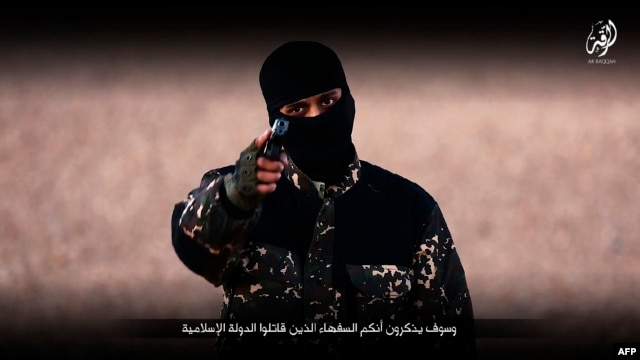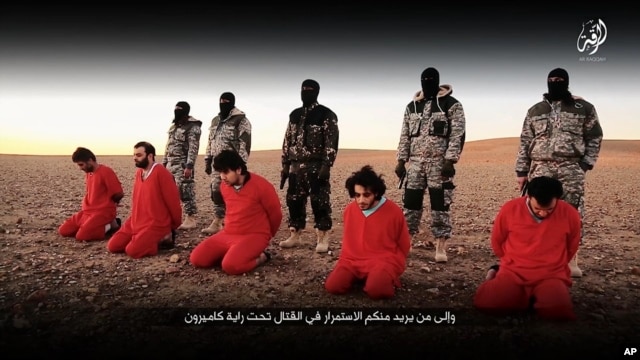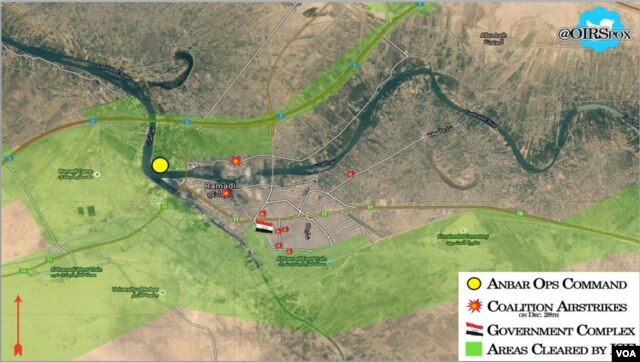News / Middle East
Why Is Islamic State So Hard to Beat?
image grab taken from a video published by the media branch of the Islamic State (IS) group in the Raqa province (Welayat Raqa) on Jan. 3, 2016, purportedly shows an English-speaking IS fighter speaking to the camera at an undisclosed location.
January 07, 2016 12:59 PM
WASHINGTON—
US strategy
The U.S. led coalition has said it is battling IS on all levels by pursuing its leadership, shrinking its safe havens, countering its financing, and puncturing its powerful idealistic narrative of a revival of a “true” caliphate.
The coalition has increased attacks against the group, blowing up oil trucks, striking fighting positions, and taking out IS leaders and operations planners.
According to coalition spokesman Colonel Steve Warren, IS today controls 40 percent less territory that it once held.
Yan St. Pierre, a counterterrorism expert for MOSECON, a security consulting company based in Berlin, agreed there have been some gains. But he cautioned against declaring any kind of victory.
“It sounds as if you are putting a dent in their armor, but they adapt. They might have some problems for three, six weeks, a few months, but they will adapt,” St. Pierre told VOA.
All aspects of IS, military, social, propaganda, have to be tackled simultaneously, he said. “If you focus on the myth, they can rebuild it. If you focus on the military, the myth will allow them to rise again and rebuild the military.”
“As long as that myth is alive, there are not enough bombs to destroy IS,” St. Pierre said, adding that as yet there are no credible, functional alternatives, and no credible unifying leaders to counter the group either in Iraq or Syria.
St. Pierre warns IS is also developing fallback positions. “They are progressively getting more and more involved in Libya, Yemen, Somalia. They are trying to build bridges that become areas they can develop.”
Solutions
Analysts differ on a solution, with some suggesting that Arab Sunni boots on the ground, such as an alliance of nations including Egypt, Saudi Arabia and UAE, is the only option.
But most agree with CIA veteran Bruce Riedel’s view that “there is a short path to catastrophic defeat in the war against al Qaida and ISIS, and that path is to make this a battle between the West and Islam.”VOA
Islamic State extremists have been bombed, strafed, derided and pushed back, yet they fight on.
“For ISIS, in very plain English, they don’t give a s--- (don't care),” said Cyril Widdershoven, a Middle East and North Africa security specialist based in the Netherlands.
With a fighting force of anywhere between 25,000 to 60,000, Islamic State militants control millions of people, thousands of square kilometers of land, and terrorize the world.
More than 9,000 punishing airstrikes, reams of satellite imagery and a plethora of local and international military forces on the ground have yet to have significant effect.
Even the victory of Iraqi forces in Ramadi, an IS-held city west of Baghdad, does not appear to have crippled the extremist group. Instead, they turned their considerable force to another city, Haditha.
Why is the group so hard to defeat?
“For ISIS, in very plain English, they don’t give a s--- (don't care),” said Cyril Widdershoven, a Middle East and North Africa security specialist based in the Netherlands.
With a fighting force of anywhere between 25,000 to 60,000, Islamic State militants control millions of people, thousands of square kilometers of land, and terrorize the world.
More than 9,000 punishing airstrikes, reams of satellite imagery and a plethora of local and international military forces on the ground have yet to have significant effect.
Even the victory of Iraqi forces in Ramadi, an IS-held city west of Baghdad, does not appear to have crippled the extremist group. Instead, they turned their considerable force to another city, Haditha.
Why is the group so hard to defeat?
This undated image, taken from video posted online Jan. 3, 2016, by the communications arm of the Islamic State group, purports to show IS militants executing five men who they accuse of having spied for Britain in Syria.
Unconventional tactics
The problem, said Widdershoven, is the United States, European and Iraqi forces continue to think of IS as a conventional military focused on holding ground.
“That is the old fashioned approach: you take one city after another. For ISIS, in their overall strategy, they don’t feel as if they are losing. They see it as ‘OK, you want A, you can have A; we will go for B, and if you want B, C, or D, we will attack where you are not’.”
Islamic State commanders have excelled at gaming strategies out, and turning battlefield losses to their advantage, analysts say.
“They are human; they will take losses. That is all part of the game,” said Kamran Bokhari, a Middle East and Countering Violent Extremism expert at the University of Ottawa.
“But when they get hit, do they become incoherent, or are we looking at an orderly retreat? I think it is an orderly retreat,” Bokhari told VOA. “This is not a demoralized force that is defeated.”
The problem, said Widdershoven, is the United States, European and Iraqi forces continue to think of IS as a conventional military focused on holding ground.
“That is the old fashioned approach: you take one city after another. For ISIS, in their overall strategy, they don’t feel as if they are losing. They see it as ‘OK, you want A, you can have A; we will go for B, and if you want B, C, or D, we will attack where you are not’.”
Islamic State commanders have excelled at gaming strategies out, and turning battlefield losses to their advantage, analysts say.
“They are human; they will take losses. That is all part of the game,” said Kamran Bokhari, a Middle East and Countering Violent Extremism expert at the University of Ottawa.
“But when they get hit, do they become incoherent, or are we looking at an orderly retreat? I think it is an orderly retreat,” Bokhari told VOA. “This is not a demoralized force that is defeated.”
FILE - Fighters from the Islamic State group parade in a commandeered Iraqi security forces armored vehicle down a main road at the northern city of Mosul, Iraq.
Learn from mistakes
IS learned from its predecessors. The group evolved out of and built on the lessons of al Qaida in Iraq, the experience of officers from Saddam Hussein’s army and international fighters hardened in places like Chechnya.
It operates on multiple levels, explained David Kilcullen, a strategy and counterinsurgency expert with Caerus Associates.
IS learned from its predecessors. The group evolved out of and built on the lessons of al Qaida in Iraq, the experience of officers from Saddam Hussein’s army and international fighters hardened in places like Chechnya.
It operates on multiple levels, explained David Kilcullen, a strategy and counterinsurgency expert with Caerus Associates.
It’s just a matter of if their losses end up outstripping their ability to adapt. I think it’s actually likely that will be the case.
- Daveed Gartenstein-Ross
- Daveed Gartenstein-Ross
It has a central state-like element, a provincial structure and an international layer of individual players.
As a result, even if it has ceased to expand territorially, because of this triple-layer structure it has been able to move fluidly between layers, sometimes responding on one while counteracting at another.
“It makes it extraordinarily resilient,” Kilcullen said at a recent conference organized by the Jamestown Foundation.
Kilcullen said IS tactics also have made it extremely difficult to quash.
It uses one-way, broadcast–based, open communications that create a lot of background clutter that intelligence agencies have to dig through. It uses a model of revolutionary terrorism, with knowledge crossing borders and teams being built close to a target. It uses remote radicalization through technology, enabling the threat to spread. It attacks in urban settings.
And it is poised to use the backlash against the migration crisis in Europe to provoke a cycle of retaliation.
As a result, even if it has ceased to expand territorially, because of this triple-layer structure it has been able to move fluidly between layers, sometimes responding on one while counteracting at another.
“It makes it extraordinarily resilient,” Kilcullen said at a recent conference organized by the Jamestown Foundation.
Kilcullen said IS tactics also have made it extremely difficult to quash.
It uses one-way, broadcast–based, open communications that create a lot of background clutter that intelligence agencies have to dig through. It uses a model of revolutionary terrorism, with knowledge crossing borders and teams being built close to a target. It uses remote radicalization through technology, enabling the threat to spread. It attacks in urban settings.
And it is poised to use the backlash against the migration crisis in Europe to provoke a cycle of retaliation.
This map shows areas cleared and airstrikes in Anbar Province, Iraq, by the U.S.-led coalition fighting Islamic State.
US strategy
The U.S. led coalition has said it is battling IS on all levels by pursuing its leadership, shrinking its safe havens, countering its financing, and puncturing its powerful idealistic narrative of a revival of a “true” caliphate.
The coalition has increased attacks against the group, blowing up oil trucks, striking fighting positions, and taking out IS leaders and operations planners.
According to coalition spokesman Colonel Steve Warren, IS today controls 40 percent less territory that it once held.
Yan St. Pierre, a counterterrorism expert for MOSECON, a security consulting company based in Berlin, agreed there have been some gains. But he cautioned against declaring any kind of victory.
“It sounds as if you are putting a dent in their armor, but they adapt. They might have some problems for three, six weeks, a few months, but they will adapt,” St. Pierre told VOA.
All aspects of IS, military, social, propaganda, have to be tackled simultaneously, he said. “If you focus on the myth, they can rebuild it. If you focus on the military, the myth will allow them to rise again and rebuild the military.”
“As long as that myth is alive, there are not enough bombs to destroy IS,” St. Pierre said, adding that as yet there are no credible, functional alternatives, and no credible unifying leaders to counter the group either in Iraq or Syria.
St. Pierre warns IS is also developing fallback positions. “They are progressively getting more and more involved in Libya, Yemen, Somalia. They are trying to build bridges that become areas they can develop.”
Solutions
Analysts differ on a solution, with some suggesting that Arab Sunni boots on the ground, such as an alliance of nations including Egypt, Saudi Arabia and UAE, is the only option.
But most agree with CIA veteran Bruce Riedel’s view that “there is a short path to catastrophic defeat in the war against al Qaida and ISIS, and that path is to make this a battle between the West and Islam.”VOA





No comments:
Post a Comment